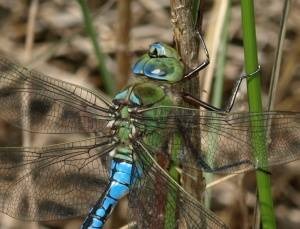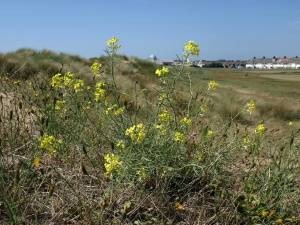Dr Phil Smith’s Wildlife Notes
June 2010
Flaming June lived up to its reputation this year with rain falling on only five days and in small quantity. The Environment Agency finally got round to issuing a statement, admitting what wildlife watchers, farmers and gardeners already knew – that the spring drought was the longest in living memory (actually since 1929!). Certainly, I have never seen the dunes so dry and we are lucky there haven’t been more large fires. Nevertheless, most of our local wildlife seems to have coped well with the extreme conditions.
A highlight of the month was a guided visit to Birkdale Green Beach on 21st with the Frodsham Naturalists. In view of the drought, we were lucky to find two adult Natterjack Toads living up to their old vernacular name “the running toad”. However, even flat-out, they wouldn’t have caught the speedy Northern Dune Tiger Beetles which were a “first” for most of the group. In damper areas, sheets of colourful marsh-orchids were a joy to behold; we identified four species: Early, Southern and Northern Marsh-orchids and the closely related Common Spotted-orchid. I was also able to point out some of the less spectacular, but rarer, members of the flora, such as the Baltic Rush and another “northern” plant, Saltmarsh Flat-sedge. One of the members drew my attention to a pink flower-spike which from a distance looked like an orchid but which, on closer examination, proved to a new plant for the Sefton Coast: Common Bistort (Persicaria bistorta). This species is more normally seen in the hilly eastern parts of our region.
A nearby dune-slack added more orchids to our list, including Bee, Pyramidal and Marsh Helleborine, while other choice plants here were the uncommon Variegated Horsetail and Greater Tussock-sedge. A small pond, still holding water, attracted several dragonflies, including a stunning male Emperor which, unusually for this hyperactive species, posed for photographs.

In my May notes, I mentioned a survey of one of our least known plants, the Slender Spike-rush. Completing the study during the month, I found 45 patches of this mainly coastal species; not bad when you consider that the New Atlas of the British & Irish Flora, published in 2002, has only one (pre-1970) record for Sefton. This apparent recent increase is probably due to the development of new habitat near the sea, especially on Birkdale Green Beach where 34 patches were recorded. Almost all the places that the plant has colonised are of relatively recent origin, providing the open conditions that it likes. I also revisited the only “old” slack where Slender Spike-rush is known in the Birkdale Sandhills, cutting my way in through dense Sea-buckthorn scrub with secateurs. However, the effort was worth it because the plant was still there and, nearby, acquaintance was renewed with the only clump of Black Bog-rush in South Lancashire, discovered by the late Neil Robinson and me in 1977. Back then, it was only a foot across; now the clump is about eight times bigger but still on its own.
Finally, Patricia Lockwood and I counted the three Sefton Coast colonies of one of our most important plants, the Isle of Man Cabbage. Confined to sand-dunes in southwest Scotland, northwest England and south Wales, it occurs nowhere else in the world. Numbers are holding up well at Crosby Marine Park and Hall Road, Blundellsands, but the Southport Marine Lake population has crashed from several hundred individuals to only nine. This plant is known to prefer open, sandy conditions but its habitat west of the lake has become more heavily vegetated in recent years, perhaps partly due to lower public pressure, these dunes having been fenced off by their private owner in 2007.

